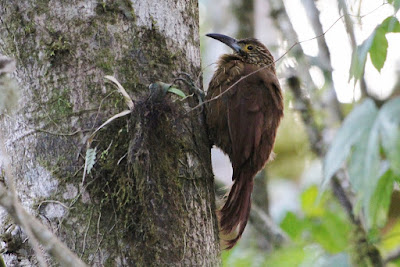The morning started with the birds coming in to eat the moths and other insects attracted to the lights in the parking lot.
The Golden-crowned Flycatcher was the first of 15 life birds for the day.
There are a lot of woodcreepers in Central and South America. This is a Strong-billed, a new bird to us.
Blue-winged Mountain-tanager. Bright and beautiful. Also a lot of yellow.
Smoke-coloured Pewee. More brown than grey, but maybe smoke is brown sometimes. This bird stayed here a long time doing the flycatcher thing, leaving and coming back. So much more obliging than warblers or vireos.
A Dusky Chlorospingus.
Or is this a Dusky Chlorospingus?
Or most likely they both are. Some of the identifications get a little tricky, especially a month or two later. If one is not a chlorospingus I'd guess it would be a female Capped Conebill.This one I am sure of. It is a Sharpe's Wren, formerly known as Sepia Brown Wren. I like it's old name better.
A warbler that sat still. A Russet-crowned Warbler, with yellow.
In the afternoon when the other birds were having their siestas we went to Quinde Luna to watch hummingbirds. It was a wonderful time. This is a Violet-tailed Sylph, an adult male as the females don't have to carry around that beautiful, long tail.
Another long-tailed bird, the Booted Racket-tail. Once again, the females don't have the long tails with the rackets at the end, but they do wear the boots.
While at Quinde Luna a Red-billed Parrot settled on the top of a nearby tree. We didn't see parrots close up on this trip, but were able to admire them through our guide's scope as well as take distant photos.
The last bird of the day was found on our way back to the lodge. One of the target birds of our group and a wonderfully colourful member of the toucan family, the Plate-billed Mountain-toucan. Once again a distant viewing.


























